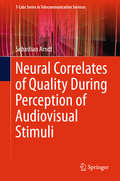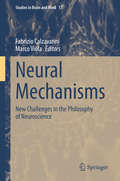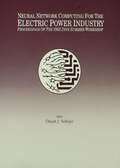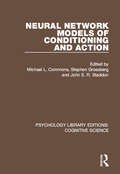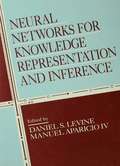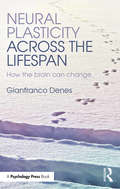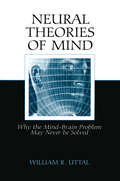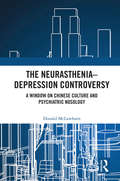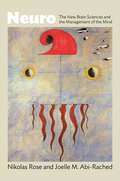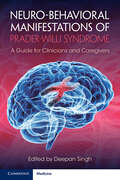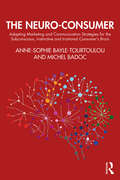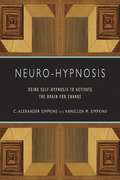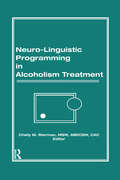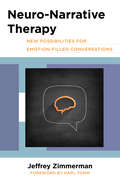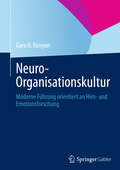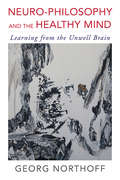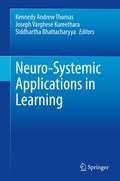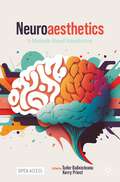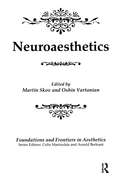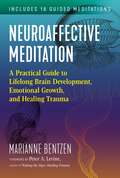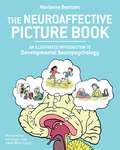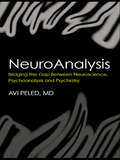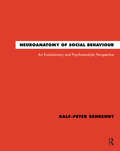- Table View
- List View
The Neural Code of Pitch and Harmony
by Langner, Gerald and Benson, Christina Gerald Langner Christina BensonHarmony is an integral part of our auditory environment. Resonances characterised by harmonic frequency relationships are found throughout the natural world and harmonic sounds are essential elements of speech, communication and, of course, music. Providing neurophysiological data and theories that are suitable to explain the neural code of pitch and harmony, the author demonstrates that musical pitch is a temporal phenomenon and musical harmony is a mathematical necessity based on neuronal mechanisms. Moreover, he offers new evidence for the role of an auditory time constant for speech and music perception as well as for similar neuronal processing mechanisms of auditory and brain waves. Successfully relating current neurophysiological results to the ancient ideas of Pythagoras, this unique title will appeal to specialists in the fields of neurophysiology, neuroacoustics, linguistics, behavioural biology and musicology as well as to a broader audience interested in the neural basis of music perception.
Neural Correlates of Quality During Perception of Audiovisual Stimuli
by Sebastian ArndtThis book presents a new approach to examining the perceived quality of audiovisual sequences. It uses electroencephalography (EEG) to explain in detail how user quality judgments are formed within a test participant, and what the physiological implications might be when subjects are exposed to lower quality media. The book redefines the experimental paradigms of using EEG in the area of quality assessment so that they better suit the requirements of standard subjective quality testing, and presents experimental protocols and stimuli that have been adjusted accordingly.
Neural Mechanisms: New Challenges in the Philosophy of Neuroscience (Studies in Brain and Mind #17)
by Fabrizio Calzavarini Marco ViolaThis volume brings together new papers advancing contemporary debates in foundational, conceptual, and methodological issues in cognitive neuroscience. The different perspectives presented in each chapter have previously been discussed between the authors, as the volume builds on the experience of Neural Mechanisms (NM) Online – webinar series on the philosophy of neuroscience organized by the editors of this volume. The contributed chapters pertain to five core areas in current philosophy of neuroscience. It surveys the novel forms of explanation (and prediction) developed in cognitive neuroscience, and looks at new concepts, methods and techniques used in the field. The book also highlights the metaphysical challenges raised by recent neuroscience and demonstrates the relation between neuroscience and mechanistic philosophy. Finally, the book dives into the issue of neural computations and representations. Assembling contributions from leading philosophers of neuroscience, this work draws upon the expertise of both established scholars and promising early career researchers.
Neural Network Computing for the Electric Power Industry: Proceedings of the 1992 Inns Summer Workshop (INNS Series of Texts, Monographs, and Proceedings Series)
by Dejan J. SobajicPower system computing with neural networks is one of the fastest growing fields in the history of power system engineering. Since 1988, a considerable amount of work has been done in investigating computing capabilities of neural networks and understanding their relevance to providing efficient solutions for outstanding complex problems of the electric power industry. A principal objective of a power utility is to provide electric energy to its customers in a secure, reliable and economic manner. Toward this aim, utility personnel are engaged in a variety of activities in areas of supervisory control and monitoring, evaluation of operating conditions, operation planning and scheduling, system development, equipment testing, etc. Over the past decades significant advances have been made in the development of new concepts, design of hardware and software systems, and implementation of solid-state devices which all contributed to the steadily improving power system performance that we are experiencing today. Advanced information processing technologies played an important role in these development efforts. Members of the Special Interest Group for Power Engineering of the INNS recognized the need for bringing together leading researchers in the field of neurocomputing with experts from power utilities and manufacturing companies to assess the current state of affairs and to explore the directions of further research and practice. This book is based on The Summer Workshop on Neural Network Computing for the Electric Power Industry which brought together approximately forty specialists with backgrounds in power engineering, system operation and planning, neural network theory and AI systems design. An informal and highly inspiring atmosphere of the workshop facilitated open discussion and exchange of expertise between the participants.
Neural Network Models of Conditioning and Action (Psychology Library Editions: Cognitive Science)
by MICHAEL L. COMMONS; STEPHEN GROSSBERG; JOHN E. R. STADDONOriginally published in 1991, this title was the result of a symposium held at Harvard University. It presents some of the exciting interdisciplinary developments of the time that clarify how animals and people learn to behave adaptively in a rapidly changing environment. The contributors focus on aspects of how recognition learning, reinforcement learning, and motor learning interact to generate adaptive goal-oriented behaviours that can satisfy internal needs – an area of inquiry as important for understanding brain function as it is for designing new types of freely moving autonomous robots. Since the authors agree that a dynamic analysis of system interactions is needed to understand these challenging phenomena – and neural network models provide a natural framework for representing and analysing such interactions – all the articles either develop neural network models or provide biological constraints for guiding and testing their design.
Neural Networks for Knowledge Representation and Inference
by Daniel S. LevineThe second published collection based on a conference sponsored by the Metroplex Institute for Neural Dynamics -- the first is Motivation, Emotion, and Goal Direction in Neural Networks (LEA, 1992) -- this book addresses the controversy between symbolicist artificial intelligence and neural network theory. A particular issue is how well neural networks -- well established for statistical pattern matching -- can perform the higher cognitive functions that are more often associated with symbolic approaches. This controversy has a long history, but recently erupted with arguments against the abilities of renewed neural network developments. More broadly than other attempts, the diverse contributions presented here not only address the theory and implementation of artificial neural networks for higher cognitive functions, but also critique the history of assumed epistemologies -- both neural networks and AI -- and include several neurobiological studies of human cognition as a real system to guide the further development of artificial ones. Organized into four major sections, this volume: * outlines the history of the AI/neural network controversy, the strengths and weaknesses of both approaches, and shows the various capabilities such as generalization and discreetness as being along a broad but common continuum; * introduces several explicit, theoretical structures demonstrating the functional equivalences of neurocomputing with the staple objects of computer science and AI, such as sets and graphs; * shows variants on these types of networks that are applied in a variety of spheres, including reasoning from a geographic database, legal decision making, story comprehension, and performing arithmetic operations; * discusses knowledge representation process in living organisms, including evidence from experimental psychology, behavioral neurobiology, and electroencephalographic responses to sensory stimuli.
Neural Plasticity Across the Lifespan: How the brain can change
by Gianfranco DenesNeural Plasticity Across the Lifespan reviews the recent scientific developments which are transforming our understanding of the human brain. For many years it was thought that modifications to the structural and functional organization of the brain were limited to a short early period of life, "the critical period", and, in adults, to the memory system. Recent research suggests that on the contrary we should see the human brain as a flexible structure, which adapts and modifies in response to learning, sensory experience, age and disease. The book provides an integrated overview of contemporary research on neural plasticity - the process by which the brain can change in structure and function to cope with new experiences and react to the effects of acquired damage or sensory deprivation. It reviews data on plasticity in the developing brain, looking at both typical and atypical development, alongside clinical and observational research on the adult population. It covers a number of key topics, including: different forms of neural plasticity factors affecting neural plasticity (ageing and gender), neural plasticity in language acquisition, memory and bodily self-consciousness mechanisms of repair – plasticity following sensory deprivation and acquired brain damage. This is an accessible overview of an emerging field of research which has fundamental implications for how we perceive our potential to change throughout our lives. It will be essential reading for all students of cognitive development, cognitive neuroscience and lifespan development.
Neural Theories of Mind: Why the Mind-Brain Problem May Never Be Solved
by William R. UttalIn this fascinating book, William R. Uttal raises the possibility that, however much we learn about the anatomy and physiology of the brain and psychology, we may never be able to cross the final bridge explaining how the mind is produced by the brain. Three main classes of mind-brain theory are considered and rejected: field theories, because they are based on a superficial analogy; single cell theories, because they emerge from a massive uncontrolled experimental program; and neural net theories, because they are constrained by combinatorial complexity.To support his argument, Uttal explores the empirical and conceptual foundations of these theoretical approaches and identifies flaws in their fundamental logic. The author concludes that the problems preventing solution of the mind-brain problem are intractable, yet well within the confines of natural science.
The Neurasthenia-Depression Controversy: A Window on Chinese Culture and Psychiatric Nosology
by Donald McLawhornThis book is about the largest debate that has occurred in the field of cultural psychiatry and its impact on diagnosing, theorizing, and clinical practice. It is also about the role of culture in psychopathology specifically in relation to China. This book is the first comprehensive and critical assessment of the anthropological psychiatry that has provided Western physicians with their ideas about somatization and culture. It is argued that psychiatric nosology and the broader cultural milieu interact in a fascinating way and co-facilitate individual conformity to culturally salient categories, consciously or unconsciously, through a process of belief, expectation, and learning. The result is that codified experiences can be translated from the mind to the body and back again. Through a critical evaluation of the Neurasthenia-Depression controversy, we can gain a view of the contested and shifting nature of psychiatric nosology, and thereby attempt to introduce the beginnings of a model that elucidates how psychiatric distress varies across cultures. This timely book challenges conventional wisdom about neurasthenia and depression in Chinese societies. Its findings will be of value to anyone who works with Chinese people with these mental illnesses across the global diaspora.
Neuro: The New Brain Sciences and the Management of the Mind
by Nikolas Rose Joelle M. Abi-RachedHow the new brain sciences are transforming our understanding of what it means to be humanThe brain sciences are influencing our understanding of human behavior as never before, from neuropsychiatry and neuroeconomics to neurotheology and neuroaesthetics. Many now believe that the brain is what makes us human, and it seems that neuroscientists are poised to become the new experts in the management of human conduct. Neuro describes the key developments—theoretical, technological, economic, and biopolitical—that have enabled the neurosciences to gain such traction outside the laboratory. It explores the ways neurobiological conceptions of personhood are influencing everything from child rearing to criminal justice, and are transforming the ways we "know ourselves" as human beings. In this emerging neuro-ontology, we are not "determined" by our neurobiology: on the contrary, it appears that we can and should seek to improve ourselves by understanding and acting on our brains.Neuro examines the implications of this emerging trend, weighing the promises against the perils, and evaluating some widely held concerns about a neurobiological "colonization" of the social and human sciences. Despite identifying many exaggerated claims and premature promises, Neuro argues that the openness provided by the new styles of thought taking shape in neuroscience, with its contemporary conceptions of the neuromolecular, plastic, and social brain, could make possible a new and productive engagement between the social and brain sciences.Copyright note: Reproduction, including downloading of Joan Miro works is prohibited by copyright laws and international conventions without the express written permission of Artists Rights Society (ARS), New York.
Neuro-behavioral Manifestations of Prader-Willi Syndrome: A Guide for Clinicians and Caregivers
by Deepan SinghThe behavioral issues experienced by individuals with Prader-Willi Syndrome (PWS) can be both surprising and overwhelming to clinicians and caregivers. Despite the distress and dysfunction posed by them, there are very few resources available to address these neuropsychiatric problems. This invaluable guidebook helps to identify and address the spectrum of behavioral issues faced by individuals with PWS. Written by a psychiatrist with unique expertise in the management of patients with this condition, this easy-to-read book explores practical details that will aid any clinician or caregiver. Chapters offer vivid case examples and clear guidance on both the behavioral and pharmacological management of issues such as anxiety, skin-picking, ADHD, disruptive behavior (including non-suicidal self-harm), mood disorders (including depression and bipolar disorder), and psychosis. Neuro-behavioral Manifestations of Prader-Willi Syndrome serves as an essential and practical companion for any caregiver or healthcare professional providing care to people with PWS.
The Neuro-Consumer: Adapting Marketing and Communication Strategies for the Subconscious, Instinctive and Irrational Consumer's Brain
by Anne-Sophie Bayle-Tourtoulou Michel BadocNeuroscientific research shows that the great majority of purchase decisions are irrational and driven by subconscious mechanisms in our brains. This is hugely disruptive to the rational, logical arguments of traditional communication and marketing practices and we are just starting to understand how organizations must adapt their strategies. This book explains the subconscious behavior of the "neuro-consumer" and shows how major international companies are using these findings to cast light on their own consumers’ behavior. Written in plain English for business and management readers with no scientific background, it focuses on: how to adapt marketing and communication to the subconscious and irrational behaviors of consumers; the direct influence of the primary senses (sight, hearing, smell, taste, touch) on purchasing decisions and the perception of communications by customers’ brains; implications for innovation, packaging, price, retail environments and advertising; the use of "nudges" and artifices to increase marketing and communication efficiency by making them neuro-compatible with the brain’s subconscious expectations; the influence of social media and communities on consumers’ decisions – when collective conscience is gradually replacing individual conscience and recommendation becomes more important than communication; and the ethical limits and considerations that organizations must heed when following these principles. Authored by two globally recognized leaders in business and neuroscience, this book is an essential companion to marketers and brand strategists interested in neuroscience and vital reading for any advanced student or researcher in this area.
Neuro-Hypnosis: Using Self-Hypnosis to Activate the Brain for Change
by Annellen M. Simpkins C. Alexander SimpkinsUnderstanding the neuroscience of self-hypnosis for more effective treatment of a variety of conditions. Drawing from over 30 years of teaching, researching, and practicing hypnosis, the authors share systematic instructions, techniques, and exercises for finding your way into a hypnotic trance--or deepen your trance if you've already found it. With exercises specifically tailored to address a wide range of concerns, including stress, depression, substance abuse, anxiety, weight management, fears, and sports performance, this book is a comprehensive guide for anyone interested in hypnosis. The authors synthesize and integrate the major theories of hypnosis and provide an overview of the fundamental tools used in self-hypnosis, especially attention, unconscious processing, and suggestion. For clinicians, they provide evidence and practical considerations that therapists need to incorporate hypnosis into their practice. All readers will benefit from the tips, techniques, and exercises throughout which demonstrate how hypnotic interventions can be tailored to each person. Readers will be inspired to practice at home using hypnotic suggestions that target their specific concerns. Deftly balancing theory and practice, Neuro-Hypnosis provides the tools you need to open yourself to self-hypnosis, experience the vast potential of your mind, and activate your brain for growth, development, and lasting change.
Neuro-Linguistic Programming in Alcoholism Treatment
by Bruce Carruth Chelly M StermanHere is a practical and clearly written guide to the use of Neuro-Linguistic Programming in the treatment of alcoholism and other addictions. This comprehensive volume illustrates how the focus of Neuro-Linguistic Programming (NLP) on the individual and the family increases the effectiveness of counseling by targeting the uniqueness of each individual and his or her family system. Professionals will also learn how NLP facilitates effective interventions and helps alcoholics create internal coping skills to begin and maintain the recovery process. Neuro-Linguistic Programming in Alcoholism Treatment is a wealth of innovative, state-of-the-art information on the history of NLP, basic NLP assumptions, concepts for establishing rapport with clients, and essential family participation in NLP.Each chapter directs itself either to a specific NLP technique, featuring clear case demonstrations and a step-by-step outline for applying the technique to the development of the counseling process in working with addicted systems, or to a particular group affected by addiction, such as alcoholics, children of alcoholics, or the addicted family as a unit. Clinicians focus on alcoholism and other addictions as treatable conditions, applying specific strategies and techniques--initially developed in Neuro-Linguistic Programming and Hypnotherapy--adapted to meet the demands of alcoholism and addiction treatment specialists. This important volume allows for a substantial increase in the repertoire of treatment choices available to professionals and enables clinicians to individualize treatment. An extensive bibliography is included to further assist readers in gaining additional skills in the treatment of alcoholics and other addicts.
Neuro-Narrative Therapy: New Possibilities For Emotion-filled Conversations
by Jeffrey ZimmermanBringing interpersonal neurobiology and narrative therapy together. Narrative therapy understands storytelling as the way we make sense of ourselves and life experience. Many non-narrative therapists have expressed great admiration and interests in the politics the work exposes, the way it brings in the socio-political context, and the way it centers clients. Yet despite its popularity and success as a useful therapeutic approach, Narrative Therapy has been criticized as minimizing and failing to develop any extended discussion of something vital to our lives: emotion. Neuro-Narrative Therapy attempts to redress this problem by taking us first through standard Narrative practices, and then showing how and where affect can be brought in and even privileged in the work. After situating the evolution of Narrative Therapy in its historical context, the book provides information about why emotions should be given an important place in the work. Specifically, it brings ideas and implications of some of the most exciting and novel theories—interpersonal neurobiology and affective neuroscience—to the practice of Narrative Therapy. Readers will learn about the growing emphasis on the right brain, and how an understanding of the ways in which emotion and affect are manifested by the brain can help us help our clients. The possibilities for this new approach are many: a freer discussion of the emotional side of your clients; an understanding and sensitivity to the relation of body and mind; attention to how the therapeutic relationship of our clients can become a resource in treatment and a renewed understanding of how our memories—and thus our stories about our lives—develop in early childhood and beyond. For any therapist working in the area of Narrative Therapy, and for any interested in the emerging understandings that science is bringing to appreciating how our brains develop with and among each other, this book has something to offer. Combining the neuro- and the narrative, as Jeffrey Zimmerman has done here, will create a new direction in Narrative Therapy, one in which our brain and body work together, inviting a more direct and effective engagement with clients.
Neuro-Organisationskultur: Moderne Führung orientiert an Hirn- und Emotionsforschung
by Garo D. Reisyan"Neuro-Organisationskultur" oder kurz "Neurokultur" baut auf die Erfahrungen auf, die in den letzten 30 Jahren mit Organisationskultur gemacht wurden und ergänzt sie um neueste Erkenntnisse aus Hirn- und Emotionsforschung sowie um wichtige Einsichten aus Soziologie und Psychologie. Die aktuelle Konzeptlandschaft zum Thema Organisationskultur ist im Kern 20-30 Jahre alt und weist für praktische Operationalisierungen gravierende Unzulänglichkeiten auf. Mit dem Konzept "Neurokultur" wird ein neuartiges Kulturmodell vorgestellt, das im Kern die drei Bausteine Reflexivität, Vorstellungen und Emotionen aufweist. Dazu führt der Autor in die neurowissenschaftlichen Grundlagen z. B. von Wahrnehmung, Gedächtnis und Lernen ein und macht mit Konstrukten, wie etwa Emotion, Stress, kognitiver Dissonanz, Intelligenz, Aufmerksamkeit und Kreativität vertraut. Neuartig ist auch, dass Gruppen und Individuen konsistent unter einem Dach konzeptualisiert wurden. Insgesamt ergibt sich ein signifikant belastbareres Verständnis von kulturellen Phänomenen und menschlichem Verhalten, wodurch sich neue Möglichkeiten der Operationalisierung eröffnen. Dazu wird ein struktureller Rahmen nebst Begriffsinventar sowie konkrete Methoden und Vorlagen zur Analyse, kontinuierlichen Pflege und gezielten Veränderung von Organisationskultur dargeboten. Schließlich werden wichtige Megatrends skizziert, auf deren Basis Anforderungen an das kulturelle Profil von Organisationen des 21. Jahrhunderts abgeleitet werden. Das praxisorientierte Buch enthält zahlreiche Beispiele aus Unternehmen und Exkurse zu aktuellen Themen aus Gesellschaft, Politik und allgemeiner Lebensführung.
Neuro-Philosophy and the Healthy Mind: Learning from the Unwell Brain
by Georg NorthoffApplying insights from neuroscience to philosophical questions about the self, consciousness, and the healthy mind. Can we “see” or “find” consciousness in the brain? How can we create working definitions of consciousness and subjectivity, informed by what contemporary research and technology have taught us about how the brain works? How do neuronal processes in the brain relate to our experience of a personal identity? Where does the brain end and the mind begin? To explore these and other questions, esteemed philosopher and neuroscientist Georg Northoff turns to examples of unhealthy minds. By investigating consciousness through its absence—in people in vegetative states, for example—we can develop a model for understanding its presence in an active, healthy person. By examining instances of distorted self-recognition in people with psychiatric disorders, like schizophrenia, we can begin to understand how the experience of “self” is established in a stable brain. Taking an integrative approach to understanding the self, consciousness, and what it means to be mentally healthy, this book brings insights from neuroscience to bear on philosophical questions. Readers will find a science-grounded examination of the human condition with far-reaching implications for psychology, medicine, our daily lives, and beyond.
Neuro-/Psychopharmaka im Kindes- und Jugendalter: Grundlagen und Therapie
by Manfred Gerlach Claudia Mehler-Wex Marcel Romanos Susanne Walitza Christoph WewetzerDas Buch vermittelt aktuell und umfassend das Wissen auf dem Gebiet der Neuro-/Psychopharmakologie. Um ein tieferes Verständnis der Therapieprinzipien sowie der Besonderheiten der medikamentösen Behandlung bei Kindern und Jugendlichen zu erhalten, werden im ersten Teil die Grundlagen der Neuro-/Psychopharmakologie dargelegt. Zudem werden rechtliche und ethische Fragen im Praxisalltag eingehend erörtert. Der zweite Teil behandelt ausführlich die verschiedenen Arzneistoffgruppen. Im dritten Teil wird die störungsspezifische und symptomorientierte Medikation praxisorientiert beschrieben und kritisch bewertet, so dass der Arzt über eine klare Handlungsanleitung verfügt. Die vierte Auflage wurde aktualisiert und auf den neusten wissenschaftlichen Stand gebracht. Dieses Nachschlagewerk besticht durch die komprimierte und einheitliche Darstellung mit vielen zweifarbigen Tabellen, Schemata und Abbildungen. Es wendet sich an Kinder- und Jugendpsychiater und -psychotherapeuten, Pädiater, Allgemeinmediziner, Psychologen, Pflegekräfte und Lehrer.
Neuro-Systemic Applications in Learning
by Siddhartha Bhattacharyya Joseph Varghese Kureethara Kennedy Andrew ThomasNeuroscience research deals with the physiology, biochemistry, anatomy and molecular biology of neurons and neural circuits and especially their association with behavior and learning. Of late, neuroscience research is playing a pivotal role in industry, science writing, government program management, science advocacy, and education. In the process of learning as experiencing knowledge, the human brain plays a vital role as the central governing system to map the images of learning in the human brain which may be called educational neuroscience. It provides means to develop a common language and bridge the gulf between educators, psychologists and neuroscientists. The emerging field of educational neuroscience presents opportunities as well as challenges for education, especially when it comes to assess the learning disorders and learning intentions of the students. The most effective learning involves recruiting multiple regions of the brain for the learning task. These regions are associated with such functions as memory, the various senses, volitional control, and higher levels of cognitive functioning. By considering biological factors, research has advanced the understanding of specific learning difficulties, such as dyslexia and dyscalculia. Likewise, neuroscience is uncovering why certain types of learning are more rewarding than others. Of late, a lot of research has gone in the field of neural networks and deep learning. It is worthwhile to consider these research areas in investigating the interplay between the human brain and human formal/natural learning. This book is intended to bring together the recent advances in neuroscience research and their influence on the evolving learning systems with special emphasis on the evolution of a learner-centric framework in outcome based education by taking into cognizance the learning abilities and intentions of the learners.
Neuroaesthetics: A Methods-Based Introduction
by Tudor Balinisteanu Kerry PriestThis open access neuroaesthetics textbook, the first in the world, is designed for teaching a semester module (14 meetings) to undergraduate/masters students from both the sciences and the humanities. Written in a style that appeals to humanities students without prior science training, and to science students without prior humanities training, the textbook contains 6 Units, material for an introductory class, and summative comments to be discussed in a closing meeting. Each Unit comprises an overview designed as student home reading, a lecture, and a lab. The labs contain detailed step-by-step instructions for running a basic experiment and analysing the collected data, that can be easily implemented in humanities and science departments alike. The textbook introduces students to philosophical considerations of neuroaesthetics topics in context of the history of empirical aesthetics, showcases experimental approaches to the empirical study of dance, the visual arts, and music, and supports hands-on training in experimental research methods.
Neuroaesthetics (Foundations and Frontiers in Aesthetics Series)
by Oshin Vartanian Arnold Berleant Martin Skov Colin MartindaleThe beginning of psychological aesthetics is normally traced back to the publication of Gustav Theodor Fechner's seminal book "Vorschule der Aesthetik" in 1876. Following in the footsteps of this rich tradition, editors Martin Skov and Oshin Vartanian view neuroaesthetics - the emerging field of inquiry concerned with uncovering the ways in which aesthetic behavior is caused by brain processes - as a natural extension of Fechner's 'empirical spirit' to understand the link between the objective and subjective worlds inherent in aesthetic experience. The editors had two specific aims for this book. The first was to highlight the diversity of approaches that are underway under the banner of neuroaesthetics.Currently, this topic is being investigated from experimental, evolutionary, neuropsychological, and neuroimaging perspectives to tackle problems in the visual arts, literature, music, and film. Its quintessentially interdisciplinary nature has functioned as a breeding ground for generating and testing hypotheses in multiple domains. The second goal was more integrative and involved distilling some of the key features common to these diverse strands of work. The book presents a possible framework for neuroaesthetics by highlighting what the contributors consider to be its defining features and offering a working definition of neuroaesthetics that captures these features. "Neuroaesthetics" will provide an empirical and theoretical framework to motivate further work in this area. Ultimately, the hope is that puzzles in aesthetics can be solved through insights from biology, but that the contribution can be truly bidirectional.
Neuroaffective Meditation: A Practical Guide to Lifelong Brain Development, Emotional Growth, and Healing Trauma
by Marianne Bentzen• Shares 16 guided meditations for neuroaffective brain development and emotional maturation, along with links to online recordings • Explores the stages of emotional development, from childhood to old age, and their potentials for developing new ways of functioning • Reveals the biopsychological effects of meditation on the human brain, including how it affects us at the autonomic, limbic, and prefrontal levels Drawing on her 25 years of research into brain development as well as decades of meditation practice, psychotherapist Marianne Bentzen shows how neuroaffective meditation--the holistic integration of meditation, neuroscience, and psychology--can be used for personal growth and conscious maturation. She also explores how the practice can help address embedded traumas and allow access to the best perspectives of growing older while keeping the best psychological attitudes of being young--a hallmark of wisdom. She explains that there is a sequence to emotional maturation, just as there is for the development of cognitive or athletic skills, and details the central developmental processes of childhood and adolescence and the adult stages of psychological development. She then explores the biopsychological effects of meditation on the human brain, including how it affects us at the autonomic, limbic, and prefrontal levels. The author shares 16 guided meditations for neuroaffective brain development (along with links to online recordings), each designed to gently interact with the deep, unconscious layers of the brain and help you reconnect to yourself, your relationships, and the world around. Each meditation explores a different theme, from breathing in &“being in your body&” to feeling love, compassion, and gratitude in &“the songs of the heart&” to balancing positive and negative experiences in &“mandala.&” The author also shares a 5-part meditation centered on breathing exercises designed to balance your energy. Presenting an authentic, stepwise approach to spiritual growth, emotional maturation, and brain development, this guide explains the science behind neuroaffective meditation and offers detailed practices for a truly personal and ever-evolving experience of inner wisdom and growth.
The Neuroaffective Picture Book: An Illustrated Introduction to Developmental Neuropsychology
by Marianne Bentzen Kim Hagen Jakob Worre FogedAn illustrated introduction to the evolution and early development of the brain, emotions, and personalityDesigned for psychologists, psychotherapists, and childcare professionals, this book is an accessible primer on developmental neuropsychology, combining easy-to-understand text with light-hearted illustrations. Covering topics such as the autonomic nervous system, neuroaffective development, the prefrontal cortex, and the zone of proximal development, The Neuroaffective Picture Book is a unique and useful tool for learning about emotions, social skills, and self-regulation.
NeuroAnalysis: Bridging the Gap between Neuroscience, Psychoanalysis and Psychiatry
by Avi PeledNeuroAnalysis investigates using the neural network and neural computation models to bridge the divide between psychology, psychoanalysis, and neuroscience when diagnosing mental health disorders and prescribing treatment. Avi Peled builds on Freud's early attempts to explain the neural basis of mental health by introducing neural computation as a bridging science to explain psychiatric disorders. Peled describes the brain as a complex system of interconnected units and goes on to suggest that conscious experience, feelings, and mood are emergent properties arising from these complex organisations. This model describes mental health disorders in terms of perturbation to the optimal brain organisation, and demonstrates how particular disorders can be identified through a specific breakdown pattern of the brain’s organisation. This fresh approach to the diagnosis of psychiatric disorders will interest students, professors, and researchers of psychoanalysis, neuroscience, and their related fields.
Neuroanatomy of Social Behaviour: An Evolutionary and Psychoanalytic Perspective
by Ralf-Peter BehrendtThis book is for readers who are knowledgeable about the neurosciences and curious about brain mechanisms that produce normal and pathological social behaviour. It is a reference work that presents and reviews facts and recent findings that need to be accounted for within a coherent neuroanatomy and neurophysiology of social behaviour.

